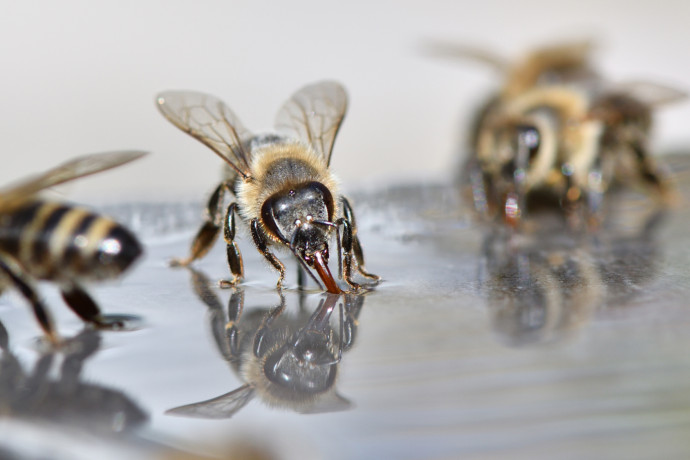Bees' needs

In this section for submissions by our Fellows, Distinguished Professor Steve Wratten writes about his research to explore 'bees' needs' in more depth. His research may overturn the accepted gospel since Aristotle about the importance of pollen and nectar for honeybees and what about their taste for 'dirty water'?
Show coloured pictures of a range of insects to New Zealand children and ask them to name as many types as they can. You can be sure that amongst the most readily identified, butterflies will rank near the top, based on the childrens’ knowledge of the ubiquitous Monarch. Grasshoppers may also feature prominently, based more on Disney cartoons than the real thing. Ladybirds must be near the top as well but surely the ‘Busy Bee’ will be the winner. Not the honeybee Apis mellifera probably; it will often be confused with a stinging wasp – but it’s the bumble bee, Bombus that they recognise. It’s the yellow/orange bands that give the game away. Everyone – child or adult – knows that bees need flowers – it’s one of the most famous mutualisms in biology. The plant benefits by being pollinated and the bees use the pollen brought to the nest by the workers as a protein source, and the nectar provides energy and other resources to bee larvae though the nurse bees. So, that has more or less been the accepted gospel for more than 2000 years; in the 4th century BC, Aristotle thought deeply and published on honeybees. But, and it’s a big but, current work in our Bio-Protection Centre of Research Excellence, hosted at Lincoln University, is showing that things are much more complex than that.
With funding from a Royal Society Te Apārangi James Cook Research Fellowship to Distinguished Prof Steve Wratten, postdoc Morgan Shields and Sarah Cairns are further exploring ‘bees' needs’ in a little more depth. For example, keen naturalists all over the world have noticed that honeybees visiting some plants madly fill their pollen baskets with pollen but show no apparent interest in the plants’ nectar.
The ‘Californian lilac’ in the buckthorn (Rhamnaceae) family, which is a lovely garden plant, swarms with honeybees which fill their pollen baskets (corbiculae) with its creamy-white pollen. The bees ignore the plants’ nectar but it does not seem to be related to the depth or structure of the nectaries. Rosemary (Rosmarinus officinalis) (Lamnaceae), in contrast, provides honeybees with abundant nectar but its pollen supplies seem to be ignored – at least in my garden. The plant cultivar could be a factor of course, influencing nectar or pollen quality, as can flowering, time of day or season, and other factors too.
More difficult to interpret, however, is honeybees’ penchant for ‘dirty water’. It is increasingly being understood that honeybees prefer a particular elemental composition of pollen. Michal Filipiak led the way in exploring this idea recently, at Jagiellonian University, Poland (Filipiak et al., 1997). The importance of the balance between elemental ratios in organisms’ growth and development was explored deeply in a review by Cherif and Elser (2016). In particular, the scarcity of Na, S, Cu, P and other elements can be key. Determined by a Trophic Stoichiometric Ratio index, when sodium in particular is in deficit, it can impose critical constraints on organisms’ growth and development.
Perhaps honeybee flower choice is based at least partially on pollen mineral stoichiometry, and equally plausible is that bees’ ‘dirty water’ foraging is involved in stoichiometry too. In 2006, Rachael Bonoan and colleagues started a chain of experimental enquiry in this area by offering honeybees a choice of mineral solutions in an open-air experiment. A sodium chloride solution was strongly preferred over Ca, P, and K solutions but the latter group became preferred in autumn when pollen supplies were limited. However, this was not a test of stoichiometry. With the James Cook funding we made stoichiometric mineral solutions and presented these to honeybees in a randomised block experiment as low, medium, high, and mixed molar solutions of six minerals, as well as sucrose and deionised water. Amazingly, the bees strongly preferred the sodium solutions over water and sucrose! This reflected the fact that many herbivores are often sodium limited. Water from puddles, ponds and even back-garden swimming pools often has honeybees drinking from the edges (see the video below).
So we are now asking the question ‘Can we increase pollen sodium content by adding NaCl to plants when they are in-bud? Can we detect the added Na in the pollen, and more importantly, can the bee foragers detect it? This work has just started, using a multi-plot, large randomised block experiment with a rented beehive and two sunflower cultivars. Bayer AG, Manheim, Germany are co-funding this work and Megan Grainger at the University of Waikato is analysing our pollen for us, using a gas chromatographic mass spectrometry QQQ apparatus. We believe that this work is a world first and maybe we can use the science of stoichiometry to lead to the making of delivery systems outside beehives that help bees survive better through difficult periods. Much better, we hope, than the current practice of offering worker bees just sucrose. Whatever the outcome, there is no doubt that our fascination with bees will continue, 2300 years after Aristotle’s imagination was captured by these amazing insects.
References
Bonoan, R.E., Tai, T.M., Rodriguez, M.Y., Feller, L., Daddario, S.R., Czaja, R.A., et al. (2016) Seasonality of salt foraging in honey bees (Apis mellifera). Ecological Entomology, 42, 195-201. DOI: 10.1111/een.12375
Cherif, M., & Esler, J. (2016) Ecological Stoichiometry. Oxford Bibliographies, DOI: 10.1093/obo/9780199830069-0146.
Filipiak, M., Kuszewska, K., Asselman, M., Denisow, B., Stawiarz, E., Woyciechowski, M., et al. (2017) Ecological stoichiometry of the honeybee: Pollen diversity and adequate species composition are needed to mitigate limitations imposed on the growth and development of bees by pollen quality. PLoS ONE, DOI: 10.13371/journal.pone.0183236
